Table of Contents
A colon is a punctuation mark that looks like two dots stacked on top of each other (:). It is often used in English writing to introduce or clarify information. Knowing how and when to use a colon can help you write clearly and make your sentences more organized.
In this post, we will explain the correct ways to use a colon, provide rules and examples, and even compare it with a similar punctuation mark, the semicolon.
What is Colon?
A colon (:) is used to introduce information or separate related ideas, making sentences clearer and more organized.
Examples:
She had one dream: to travel the world.
I have three favorite colors: blue, green, and yellow.
He had one goal: to win the game.
When to Use a Colon
A colon is used in several specific situations to help organize and clarify writing. Understanding when and how to use a colon correctly will make your writing clearer and more professional. Below are the main situations where a colon is used, along with examples.
1. To Introduce a List
A colon is often used after a complete sentence to introduce a list of items. The sentence before the colon must be complete on its own, and the colon signals that what follows will elaborate on that sentence.
- I need to buy three things from the store: bread, milk, and eggs.
- She packed her suitcase with these items: clothes, shoes, and toiletries.
Rule: The sentence before the colon should be complete, meaning it must have a subject and a verb.
(Wrong Use):
- The ingredients needed are: sugar, flour, and eggs.
- Wrong because “The ingredients needed are” is not a complete sentence.
Correct:
- You will need the following ingredients: sugar, flour, and eggs.
2. To Provide an Explanation or Clarification
A colon can be used to introduce an explanation or clarification that expands on the sentence before it. In this case, what follows the colon explains or gives more details about the statement before it.
- There is only one rule: always be kind.
- He finally realized the truth: hard work pays off.
- She had one goal: to graduate with honors.
Rule: The part before the colon must be a complete sentence, and what comes after should clarify or explain that idea.
3. To Introduce a Quote or Speech
Use a colon when introducing a quote, especially when the introduction is a complete sentence. The colon sets up the quote by indicating that what follows is directly related to what was mentioned.
- The teacher said: You must submit your assignments by Friday.
- She whispered: I love you.
Rule: Make sure the sentence before the colon is complete.
4. Between Two Related Sentences
A colon can link two independent clauses when the second sentence explains, summarizes, or elaborates on the first. The second clause should clarify or follow logically from the first.
- He had only one thing on his mind: winning the game.
- The decision was clear: they had to leave immediately.
- The weather was perfect: sunny and cool.
Rule: Both parts of the sentence before and after the colon should be able to stand alone as complete sentences.
5. In Formal Writing or Business Letters
In formal writing, such as business letters or emails, a colon is used after the salutation (greeting).
- Dear Mr. Smith:
- To Whom It May Concern:
Rule: This usage is specific to formal contexts like professional communication.
6. For Emphasis
A colon can be used to emphasize a specific word or phrase, drawing attention to something important.
- There was only one solution: perseverance.
- His greatest strength was clear: his determination.
Rule: The sentence before the colon should be complete, and the colon adds emphasis to the idea that follows.
7. In Titles and Subtitles
Colons are commonly used in titles to separate the main title from the subtitle.
- The Art of Writing: A Guide for Beginners.
- Time Management: How to Get Things Done Efficiently.
Rule: The colon separates the two parts of the title clearly.
8. With Numbers or Ratios
Colons are also used in numbers, such as time, ratios, and references.
- The train leaves at 10:30 AM.
- The ratio of students to teachers is 20:1.
Rule: In time, it separates hours from minutes. In ratios, it separates the parts being compared.
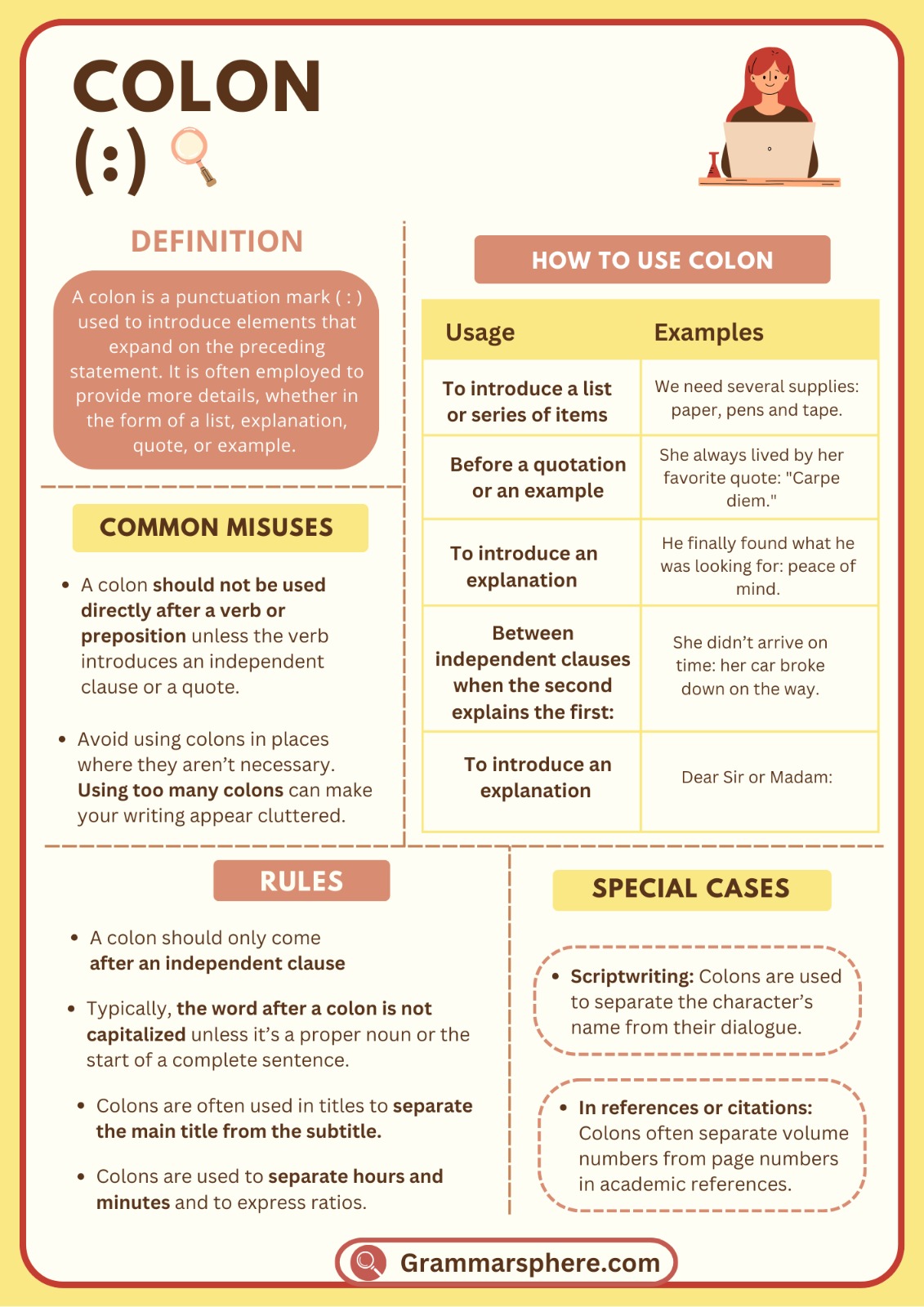
Example Sentences with Colon
- There are three things you need to succeed:
- hard work, patience, and persistence.
- The meeting is scheduled for one time only: 2:00 PM on Thursday.
- He had one main goal: to finish the project on time.
- She gave me the following advice: never give up and always stay focused.
- I bought several items from the store: apples, bananas, and oranges.
- The company’s motto is simple: Quality comes first.
- He realized the truth: honesty is always the best policy.
- There was only one option left: to call for help.
- My weekend plans are clear: relax, read a book, and enjoy a good movie.
- The result was obvious: they had won the competition
When not To Use Colon
1. After Incomplete Sentences
A colon should not follow a sentence that cannot stand alone.
- Incorrect: My favorite fruits are: apples, bananas, and oranges.
- Correct: My favorite fruits are apples, bananas, and oranges.
2. Between a Verb and Its Object
Do not place a colon between a verb and its direct object.
- Incorrect: She wants to eat: pizza for dinner.
- Correct: She wants to eat pizza for dinner.
3. After Prepositions
Avoid using a colon after prepositions like “including” or “such as.”
- Incorrect: I enjoy many sports, including: soccer, basketball, and tennis.
- Correct: I enjoy many sports, including soccer, basketball, and tennis.
4. With a Fragment
A colon should not be used to introduce a fragment or an incomplete thought.
- Incorrect: The main ingredients are: flour, sugar, and eggs.
- Correct: The main ingredients are flour, sugar, and eggs.
5. With a Quote or Speech Following a Verb
When introducing a quote or direct speech that follows a verb, it’s better to avoid a colon unless the introduction is a complete sentence.
- Incorrect: She said: “I will be there.”
- Correct: She said she would be there.
6. In Lists Following a Verb
Do not use a colon when a list immediately follows a verb.
- Incorrect: You will need: a pen, paper, and a notebook.
- Correct: You will need a pen, paper, and a notebook.
7. In Compound Sentences Without a Relationship
A colon should not separate two independent clauses that are not directly related.
- Incorrect: I went to the store: I bought some milk.
- Correct: I went to the store, and I bought some milk.
8. When a Semicolon or Comma is More Appropriate
Avoid using a colon when a semicolon or comma would work better.
- Incorrect: She loves cooking: especially Italian food.
- Correct: She loves cooking, especially Italian food.
Common Colon Mistakes
1. Using a Colon After an Incomplete Sentence
A common mistake is placing a colon after a sentence that cannot stand alone.
- My favorite hobbies are: reading, traveling, and cooking. ❌
- My favorite hobbies are reading, traveling, and cooking. ✔️
2. Placing a Colon Between a Verb and Its Object
Avoid using a colon between a verb and its direct object, as this disrupts the sentence structure.
- He decided to play: soccer after school. ❌
- He decided to play soccer after school. ✔️
3. Using a Colon After Prepositions
Many writers mistakenly place a colon after prepositions such as “including.”
- The cake has several flavors, including: chocolate, vanilla, and strawberry. ❌
- The cake has several flavors, including chocolate, vanilla, and strawberry. ✔️
4. Introducing a Fragment with a Colon
Using a colon to introduce an incomplete thought or fragment is incorrect.
- The rules are: clear and easy to follow. ❌
- The rules are clear and easy to follow. ✔️
5. Using a Colon Before a Quote That Follows a Verb
A colon is unnecessary when directly introducing a quote after a verb unless the introduction is a complete sentence.
- He exclaimed: “What a beautiful day!” ❌
- He exclaimed that it was a beautiful day. ✔️
Colon Vs Semicolon
Colon (:)
A colon is used to introduce extra information, like a list, an explanation, or a quote. It comes after a complete sentence and shows that what follows is related to that sentence. For instance, you might say, You need the following items: a notebook, a pen, and a ruler.” Here, the colon introduces the list of items needed.
Examples of Colon:
- She has two pets: a cat and a dog.
- Remember to bring: snacks, drinks, and games for the trip.
- He said this: “Always do your best.”
Semicolon (;)
A semicolon connects two closely related independent clauses that could stand alone as separate sentences. It helps to show a strong relationship between the two ideas. For example, you could say, I wanted to watch a movie; my friend preferred to go out. This shows that both thoughts are connected.
Examples of Semicolon:
- I enjoy hiking; it helps me relax.
- The weather was beautiful; we decided to have a picnic.
- She loves to read; her favorite genre is mystery.
Can we Capitalize the word after Colon?
In most cases, you should not capitalize the word after a colon unless it’s the start of a proper noun or a complete sentence. Here’s a simple guide:
When Not to Capitalize:
When the information following the colon is not a complete sentence or starts with a common noun.
- He brought three things: a book, a pen, and a notepad.
When to Capitalize:
When the information after the colon is a full sentence or a proper noun.
- She had one goal: She wanted to win the race.
You May Also Like

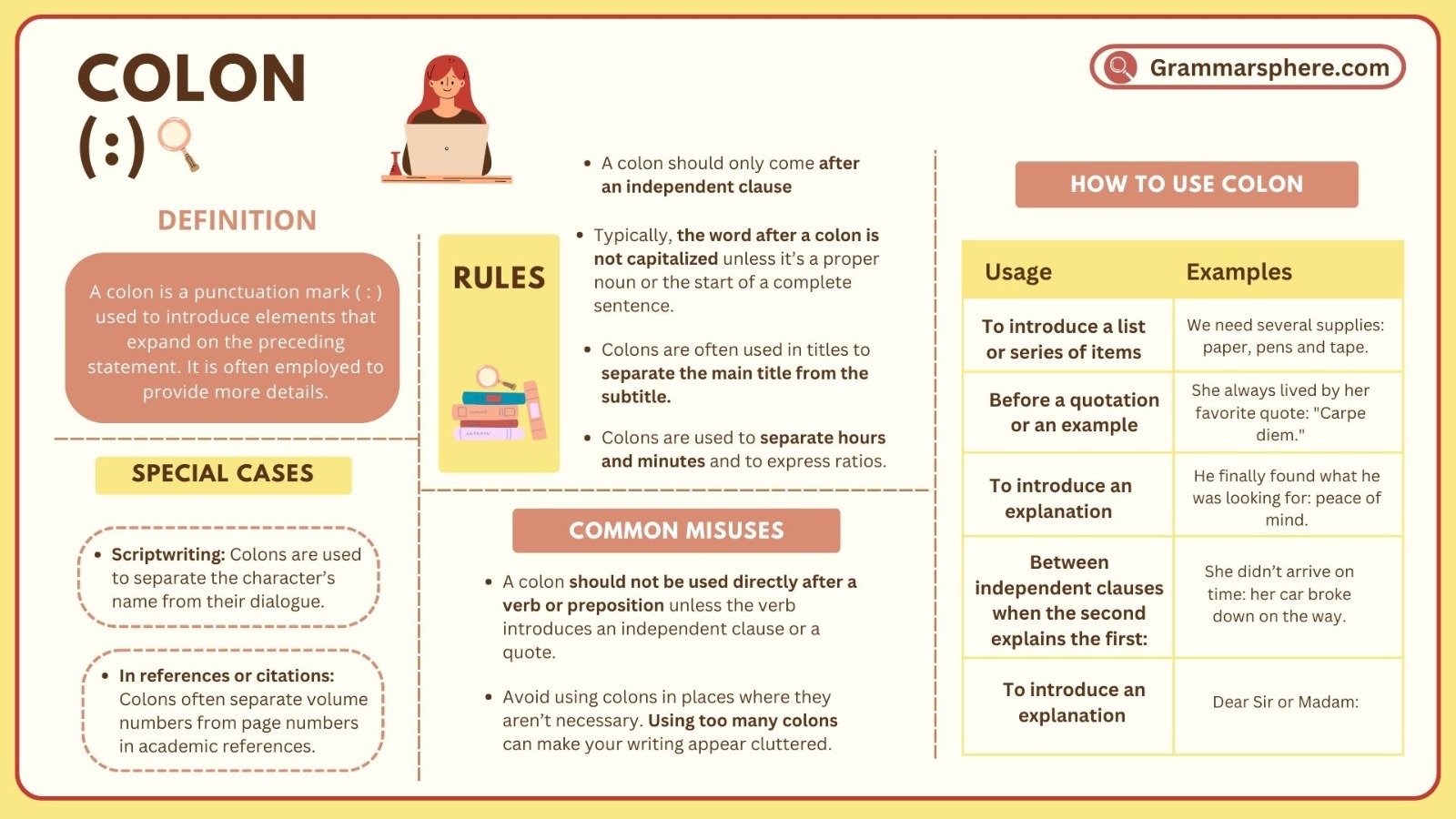
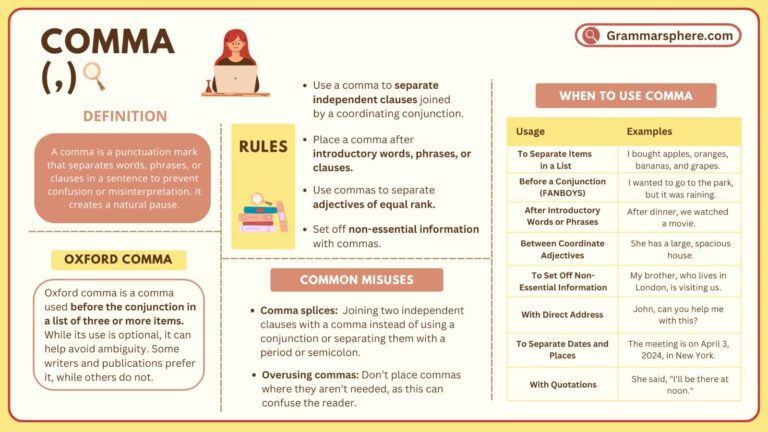
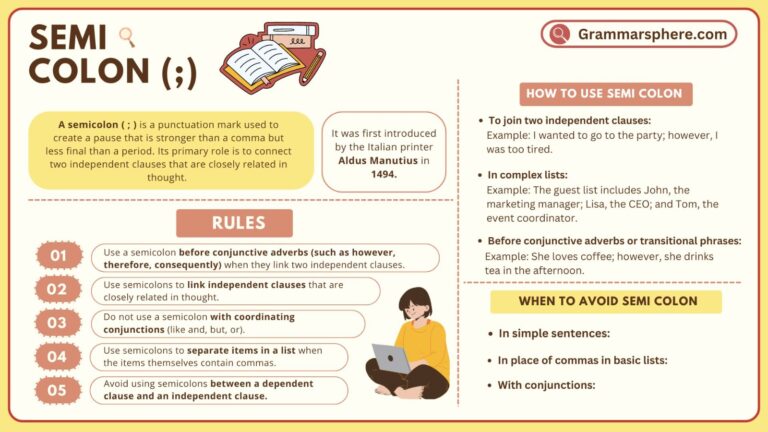
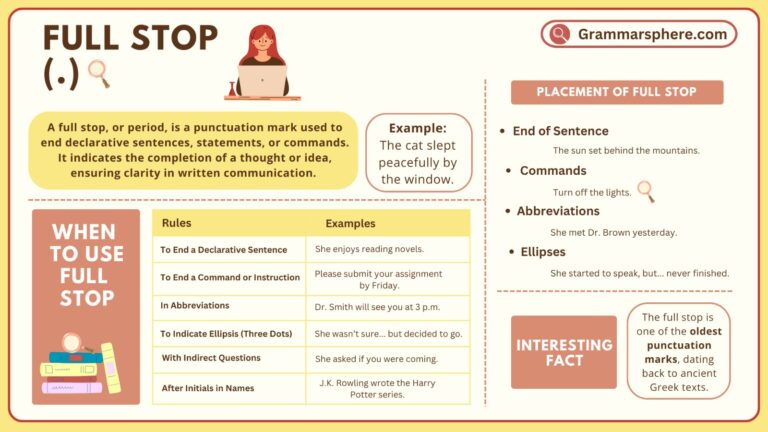
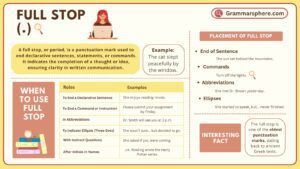

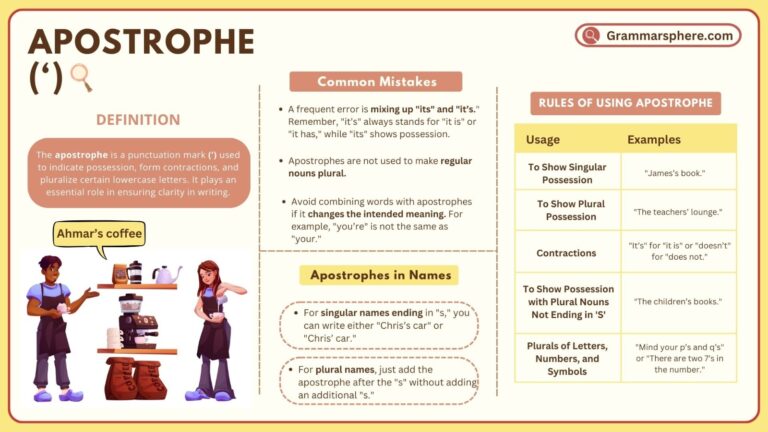
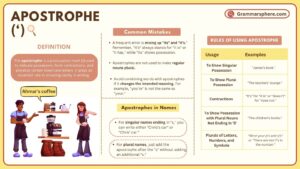
Leave a Comment